Paleocene
| Paleocene | |||||||||||
|---|---|---|---|---|---|---|---|---|---|---|---|
| Chronology | |||||||||||
| |||||||||||
| Etymology | |||||||||||
| Name formality | Formal | ||||||||||
| Name ratified | 1978 | ||||||||||
| Alternate spelling(s) | Palaeocene | ||||||||||
| Usage information | |||||||||||
| Regional usage | Global ( | ||||||||||
| Upper boundary GSSP | Dababiya section, Luxor, Egypt[3] 25°30′00″N 32°31′52″E / 25.5000°N 32.5311°E | ||||||||||
| Upper GSSP ratified | 2003[3] | ||||||||||
The Paleocene ( Epoch (which succeeds the Paleocene), translating to "the old part of the Eocene".
The epoch is bracketed by two major events in Earth's history. The
In the Paleocene, the continents of the Northern Hemisphere were still connected via some land bridges; and South America, Antarctica, and Australia had not completely separated yet. The Rocky Mountains were being uplifted, the Americas had not yet joined, the Indian Plate had begun its collision with Asia, and the North Atlantic Igneous Province was forming in the third-largest magmatic event of the last 150 million years. In the oceans, the thermohaline circulation probably was much different from what it is today, with downwellings occurring in the North Pacific rather than the North Atlantic, and water density mainly being controlled by salinity rather than temperature.
The K–Pg extinction event caused a floral and faunal turnover of species, with previously abundant species being replaced by previously uncommon ones. In the Paleocene, with a global average temperature of about 24–25 °C (75–77 °F), compared to 14 °C (57 °F) in more recent times, the Earth had a
Etymology
The word "Paleocene" was first used by French
The term "Paleocene" is a
Geology
Boundaries
The Paleocene Epoch is the 10 million year time interval directly after the
The
The Paleocene ended with the
Stratigraphy
Geologists divide the rocks of the Paleocene into a
The Danian was first defined in 1847 by German-Swiss geologist Pierre Jean Édouard Desor based on the Danish chalks at Stevns Klint and Faxse, and was part of the Cretaceous, succeeded by the Tertiary Montian Stage.[25][26] In 1982, after it was shown that the Danian and the Montian are the same, the ICS decided to define the Danian as starting with the K–Pg boundary, thus ending the practice of including the Danian in the Cretaceous. In 1991, the GSSP was defined as a well-preserved section in the El Haria Formation near El Kef, Tunisia, 36°09′13″N 8°38′55″E / 36.1537°N 8.6486°E, and the proposal was officially published in 2006.[27]
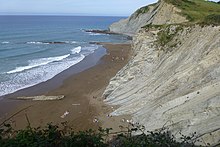
The Selandian and Thanetian are both defined in Itzurun beach by the
The Selandian was first proposed by Danish geologist Alfred Rosenkrantz in 1924 based on a section of fossil-rich
The Thanetian was first proposed by Swiss geologist
Mineral and hydrocarbon deposits
Several economically important coal deposits formed during the Paleocene, such as the
Impact craters
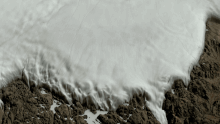
Paleogeography
Paleotectonics
During the Paleocene, the continents continued to drift toward their present positions.[50] In the Northern Hemisphere, the former components of Laurasia (North America and Eurasia) were, at times, connected via land bridges: Beringia (at 65.5 and 58 mya) between North America and East Asia, the De Geer route (from 71 to 63 mya) between Greenland and Scandinavia, the Thulean route (at 57 and 55.8 mya) between North America and Western Europe via Greenland, and the Turgai route connecting Europe with Asia (which were otherwise separated by the Turgai Strait at this time).[51][52]
The Laramide orogeny, which began in the Late Cretaceous, continued to uplift the Rocky Mountains; it ended at the end of the Paleocene.[53] Because of this and a drop in sea levels resulting from tectonic activity, the Western Interior Seaway, which had divided the continent of North America for much of the Cretaceous, had receded.[54]
Between about 60.5 and 54.5 mya, there was heightened volcanic activity in the North Atlantic region—the third largest magmatic event in the last 150 million years—creating the North Atlantic Igneous Province.[55][56] The proto-Iceland hotspot is sometimes cited as being responsible for the initial volcanism, though rifting and resulting volcanism have also contributed.[56][57][58] This volcanism may have contributed to the opening of the North Atlantic Ocean and seafloor spreading, the divergence of the Greenland Plate from the North American Plate,[59] and, climatically, the PETM by dissociating methane clathrate crystals on the seafloor resulting in the mass release of carbon.[55][60]
North and South America remained separated by the

A) Early Cretaceous
B) Late Cretaceous
C) Paleocene
D) Present
The components of the former southern supercontinent
Paleoceanography
In the modern
There is evidence of deep water formation in the North Pacific to at least a depth of about 2,900 m (9,500 ft). The elevated global deep water temperatures in the Paleocene may have been too warm for thermohaline circulation to be predominately heat driven.[67][68] It is possible that the greenhouse climate shifted precipitation patterns, such that the Southern Hemisphere was wetter than the Northern, or the Southern experienced less evaporation than the Northern. In either case, this would have made the Northern more saline than the Southern, creating a density difference and a downwelling in the North Pacific traveling southward.[67] Deep water formation may have also occurred in the South Atlantic.[69]
It is largely unknown how global currents could have affected global temperature. The formation of the Northern Component Waters by Greenland in the Eocene—the predecessor of the AMOC—may have caused an intense warming in the North Hemisphere and cooling in the Southern, as well as an increase in deep water temperatures.[66] In the PETM, it is possible deep water formation occurred in saltier tropical waters and moved polewards, which would increase global surface temperatures by warming the poles.[21][68] Also, Antarctica was still connected to South America and Australia, and, because of this, the Antarctic Circumpolar Current—which traps cold water around the continent and prevents warm equatorial water from entering—had not yet formed. Its formation may have been related in the freezing of the continent.[70] Warm coastal upwellings at the poles would have inhibited permanent ice cover.[68] Conversely, it is possible deep water circulation was not a major contributor to the greenhouse climate, and deep water temperatures more likely change as a response to global temperature change rather than affecting it.[67][68]
In the Arctic, coastal upwelling may have been largely temperature and wind-driven. In summer, the land surface temperature was probably higher than oceanic temperature, and the opposite was true in the winter, which is consistent with
Climate
Average climate
The Paleocene climate was, much like in the Cretaceous, tropical or
The poles probably had a
Global deep water temperatures in the Paleocene likely ranged from 8–12 °C (46–54 °F),[67][68] compared to 0–3 °C (32–37 °F) in modern day.[82] Based on the upper limit, average sea surface temperatures (SSTs) at 60°N and S would have been the same as deep sea temperatures, at 30°N and S about 23 °C (73 °F), and at the equator about 28 °C (82 °F).[68] In the Danish Palaeocene sea, SSTs were cooler than those of the preceding Late Cretaceous and the succeeding Eocene.[83] The Paleocene foraminifera assemblage globally indicates a defined deep-water thermocline (a warmer mass of water closer to the surface sitting on top of a colder mass nearer the bottom) persisting throughout the epoch.[84] The Atlantic foraminifera indicate a general warming of sea surface temperature–with tropical taxa present in higher latitude areas–until the Late Paleocene when the thermocline became steeper and tropical foraminifera retreated back to lower latitudes.[85]
Early Paleocene atmospheric CO2 levels at what is now
Climatic events
The effects of the meteor impact and volcanism 66 mya and the
The Dan–C2 Event 65.2 mya in the early Danian spanned about 100,000 years, and was characterized by an increase in carbon, particularly in the deep sea. Since the mid-Maastrichtian, more and more carbon had been sequestered in the deep sea possibly due to a global cooling trend and increased circulation into the deep sea. The Dan–C2 event may represent a release of this carbon after deep sea temperatures rose to a certain threshold, as warmer water can dissolve a lesser amount of carbon.[96] Savanna may have temporarily displaced forestland in this interval.[97]
Following the extreme disruptions in the aftermath of the K-Pg extinction event, the relatively cool, though still greenhouse, conditions of the Late Cretaceous-Early Palaeogene Cool Interval (LKEPCI) that began in the Late Cretaceous continued.[98]
Around 62.2 mya in the late Danian, there was a warming event and evidence of ocean acidification associated with an increase in carbon;[99] at this time, there was major seafloor spreading in the Atlantic and volcanic activity along the southeast margin of Greenland. The Latest Danian Event, also known as the Top Chron C27n Event, lasted about 200,000 years and resulted in a 1.6–2.8 °C increase in temperatures throughout the water column. Though the temperature in the latest Danian varied at about the same magnitude, this event coincides with an increase of carbon.[100]
About 60.5 mya at the Danian/Selandian boundary, there is evidence of anoxia spreading out into coastal waters, and a drop in sea levels which is most likely explained as an increase in temperature and evaporation, as there was no ice at the poles to lock up water.[101]
During the mid-Palaeocene biotic event (MPBE), also known as the Early Late Palaeocene Event (ELPE),
From 59.7 to 58.1 Ma, during the late Selandian and early Thanetian, organic carbon burial resulted in a period of climatic cooling, sea level fall and transient ice growth. This interval saw the highest
Paleocene–Eocene Thermal Maximum
The Paleocene–Eocene Thermal Maximum was an approximately 200,000-year-long event where the global average temperature rose by some 5 to 8 °C (9 to 14 °F),
Flora
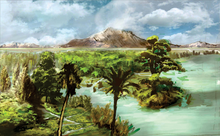
The warm, wet climate supported tropical and subtropical forests worldwide, mainly populated by
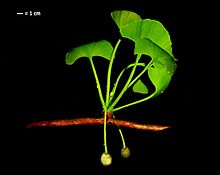
The extinction of large herbivorous dinosaurs may have allowed the forests to grow quite dense,[74] and there is little evidence of wide open plains.[117] Plants evolved several techniques to cope with high plant density, such as buttressing to better absorb nutrients and compete with other plants, increased height to reach sunlight, larger diaspore in seeds to provide added nutrition on the dark forest floor, and epiphytism where a plant grows on another plant in response to less space on the forest floor.[117] Despite increasing density—which could act as fuel—wildfires decreased in frequency from the Cretaceous to the early Eocene as the atmospheric oxygen levels decreased to modern day levels, though they may have been more intense.[120]
Recovery
There was a major die-off of plant species over the boundary; for example, in the Williston Basin of North Dakota, an estimated 1/3 to 3/5 of plant species went extinct.[121] The K–Pg extinction event ushered in a floral turnover; for example, the once commonplace Araucariaceae conifers were almost fully replaced by Podocarpaceae conifers, and the Cheirolepidiaceae, a group of conifers that had dominated during most of the Mesozoic but had become rare during the Late Cretaceous became dominant trees in Patagonia, before going extinct.[122][117][123] Some plant communities, such as those in eastern North America, were already experiencing an extinction event in the late Maastrichtian, particularly in the 1 million years before the K–Pg extinction event.[124] The "disaster plants" that refilled the emptied landscape crowded out many Cretaceous plants, and resultantly, many went extinct by the middle Paleocene.[71]
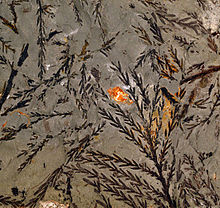
The
In general, the forests of the Paleocene were species-poor, and diversity did not fully recover until the end of the Paleocene.
Angiosperms
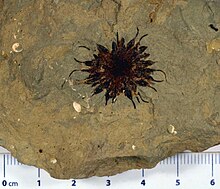
Flowering plants (
In what is now the
In the Gulf Coast, angiosperms experienced another extinction event during the PETM, which they recovered quickly from in the Eocene through immigration from the Caribbean and Europe. During this time, the climate became warmer and wetter, and it is possible that angiosperms evolved to become stenotopic by this time, able to inhabit a narrow range of temperature and moisture; or, since the dominant floral ecosystem was a highly integrated and complex closed-canopy rainforest by the middle Paleocene, the plant ecosystems were more vulnerable to climate change.[124] There is some evidence that, in the Gulf Coast, there was an extinction event in the late Paleocene preceding the PETM, which may have been due to the aforementioned vulnerability of complex rainforests, and the ecosystem may have been disrupted by only a small change in climate.[131]
Polar forests

The warm Paleocene climate, much like that of the Cretaceous, allowed for diverse polar forests. Whereas precipitation is a major factor in plant diversity nearer the equator, polar plants had to adapt to varying light availability (polar nights and midnight suns) and temperatures. Because of this, plants from both poles independently evolved some similar characteristics, such as broad leaves. Plant diversity at both poles increased throughout the Paleocene, especially at the end, in tandem with the increasing global temperature.[132]
At the North Pole, woody angiosperms had become the dominant plants, a reversal from the Cretaceous where herbs proliferated. The Iceberg Bay Formation on Ellesmere Island, Nunavut (latitude 75–80° N) shows remains of a late Paleocene dawn redwood forest, the canopy reaching around 32 m (105 ft), and a climate similar to the Pacific Northwest.[74] On the Alaska North Slope, Metasequoia was the dominant conifer. Much of the diversity represented migrants from nearer the equator. Deciduousness was dominant, probably to conserve energy by retroactively shedding leaves and retaining some energy rather than having them die from frostbite.[132]
At the South Pole, due to the increasing isolation of Antarctica, many plant taxa were endemic to the continent instead of migrating down. Patagonian flora may have originated in Antarctica.
Fauna
In the K–Pg extinction event, every land animal over 25 kg (55 lb) was wiped out, leaving open several niches at the beginning of the epoch.[134]
Mammals
Mammals had first appeared in the
In general, Paleocene mammals retained this small size until near the end of the epoch, and, consequently, early mammal bones are not well preserved in the fossil record, and most of what is known comes from fossil teeth.

Nonetheless, following the K–Pg extinction event, mammals very quickly diversified and filled the empty niches.
Though there was an explosive diversification, the
Birds

According to DNA studies, modern birds (
Almost all archaic birds (any bird outside Neornithes) went extinct during the K–Pg extinction event, although the archaic Qinornis is recorded in the Paleocene.[152] Their extinction may have led to the proliferation of neornithine birds in the Paleocene, and the only known Cretaceous neornithine bird is the waterbird Vegavis, and possibly also the waterbird Teviornis.[155]
In the Mesozoic, birds and
Reptiles

It is generally believed all non-avian dinosaurs went extinct at the K–Pg extinction event 66 mya, though there are a couple of controversial claims of
In the wake of the K–Pg extinction event, 83% of lizard and snake (
Freshwater crocodilians and choristoderans were among the aquatic reptiles to have survived the K–Pg extinction event, probably because freshwater environments were not as impacted as marine ones.[166] One example of a Paleocene crocodile is Borealosuchus, which averaged 3.7 m (12 ft) in length at the Wannagan Creek site.[167] Among crocodyliformes, the aquatic and terrestrial dyrosaurs and the fully terrestrial sebecids would also survive the K-Pg extinction event, and a late surviving member of Pholidosauridae is also known from the Danian of Morocco.[168] Three choristoderans are known from the Paleocene: The gharial-like neochoristoderans Champsosaurus—the largest is the Paleocene C. gigas at 3 m (9.8 ft), Simoedosaurus—the largest specimen measuring 5 m (16 ft), and an indeterminate species of the lizard like non-neochoristoderan Lazarussuchus around 44 centimetres in length.[169] The last known choristoderes, belonging to the genus Lazarussuchus, are known from the Miocene.[170]
Turtles experienced a decline in the Campanian (Late Cretaceous) during a cooling event, and recovered during the PETM at the end of the Paleocene.[171] Turtles were not greatly affected by the K–Pg extinction event, and around 80% of species survived.[172] In Colombia, a 60 million year old turtle with a 1.7 m (5 ft 7 in) carapace, Carbonemys, was discovered.[173]
Amphibians
There is little evidence amphibians were affected very much by the K–Pg extinction event, probably because the freshwater habitats they inhabited were not as greatly impacted as marine environments.[174] In the Hell Creek Formation of eastern Montana, a 1990 study found no extinction in amphibian species across the boundary.[175] The true toads evolved during the Paleocene.[176] The final record of albanerpetontids from North America and outside of Europe and Anatolia, an unnamed species of Albanerpeton, is known from the Paleocene aged Paskapoo Formation in Canada.[177]
Fish

The small
Conversely, sharks and rays appear to have been unable to exploit the vacant niches, and recovered the same pre-extinction abundance.
Several Paleocene freshwater fish are recorded from North America, including bowfins, gars, arowanas, Gonorynchidae, common catfish, smelts, and pike.[190]
Insects and arachnids

Insect recovery varied from place to place. For example, it may have taken until the PETM for insect diversity to recover in the western interior of North America, whereas Patagonian insect diversity had recovered by four million years after the K–Pg extinction event. In some areas, such as the Bighorn Basin in Wyoming, there is a dramatic increase in plant predation during the PETM, although this is probably not indicative of a diversification event in insects due to rising temperatures because plant predation decreases following the PETM. More likely, insects followed their host plant or plants which were expanding into mid-latitude regions during the PETM, and then retreated afterward.[129][191]
The middle-to-late Paleocene French
The Wyoming

There is a gap in the
About 80% of the butterfly and moth (lepidopteran) fossil record occurs in the early Paleogene, specifically the late Paleocene and the middle-to-late Eocene. Most Paleocene lepidopteran compression fossils come from the Danish Fur Formation. Though there is low family-level diversity in the Paleocene compared to later epochs, this may be due to a largely incomplete fossil record.[196] The evolution of bats had a profound effect on lepidopterans, which feature several anti-predator adaptations such as echolocation jamming and the ability to detect bat signals.[197]
Bees were likely heavily impacted by the K–Pg extinction event and a die-off of flowering plants, though the bee fossil record is very limited.
Though the Eocene features, by far, the highest proportion of known fossil spider species, the Paleocene spider assemblage is quite low.[200] Some spider groups began to diversify around the PETM, such as jumping spiders,[201] and possibly coelotine spiders (members of the funnel weaver family).[202]
The diversification of mammals had a profound effect on parasitic insects, namely the evolution of bats, which have more ectoparasites than any other known mammal or bird. The PETM's effect on mammals greatly impacted the evolution of fleas, ticks, and oestroids.[203]
Marine invertebrates
Among marine invertebrates, plankton and those with a planktonic stage in their development (meroplankton) were most impacted by the K–Pg extinction event, and plankton populations crashed. Nearly 90% of all calcifying plankton species perished. This reverberated up and caused a global marine food chain collapse, namely with the extinction of ammonites and large raptorial marine reptiles. Nonetheless, the rapid diversification of large fish species indicates a healthy plankton population through the Paleocene.[178]
Marine invertebrate diversity may have taken about 7 million years to recover, though this may be a preservation artifact as anything smaller than 5 mm (0.20 in) is unlikely to be fossilized, and body size may have simply decreased across the boundary.[204] A 2019 study found that in Seymour Island, Antarctica, the marine life assemblage consisted primarily of burrowing creatures—such as burrowing clams and snails—for around 320,000 years after the K–Pg extinction event, and it took around a million years for the marine diversity to return to previous levels. Areas closer to the equator may have been more affected.[88] Sand dollars first evolved in the late Paleocene.[205] The Late Cretaceous decapod crustacean assemblage of James Ross Island appears to have been mainly pioneer species and the ancestors of modern fauna, such as the first Antarctic crabs and the first appearance of the lobsters of the genera Linuparus, Metanephrops, and Munidopsis which still inhabit Antarctica today.[206]
In the Cretaceous, the main reef-building creatures were the box-like
See also
Notes
- ^ In Lyell's time, epochs were divided into periods. In modern geology, periods are divided into epochs.
References
- ^ "International Chronostratigraphic Chart". International Commission on Stratigraphy.
- ^ doi:10.18814/epiiugs/2006/v29i4/004. Archived from the original(PDF) on 7 December 2012. Retrieved 14 September 2012.
- ^ .
- ISBN 3-12-539683-2
- Schimper, W. P. (1874). Traité de Paléontologie Végétale [Treatise on Paleobotany] (in French). Vol. 3. Paris J.G. Bailliere. pp. 680–689.
- ^ (PDF) from the original on 20 June 2016.
- ^ Desnoyers, J. (1829). "Observations sur un ensemble de dépôts marins plus récents que les terrains tertiaires du bassin de la Seine, et constituant une formation géologique distincte; précédées d'un aperçu de la nonsimultanéité des bassins tertiares" [Observations on a set of marine deposits more recent than the tertiary terrains of the Seine basin and constitute a distinct geological formation; preceded by an outline of the non-simultaneity of tertiary basins]. Annales des Sciences Naturelles (in French). 16: 171–214. Archived from the original on 10 September 2018. Retrieved 20 October 2019.
- ^ Lyell, C. (1833). Principles of Geology. Vol. 3. Geological Society of London. p. 378.
- ^ Phillips, J. (1840). "Palæozoic series". Penny Cyclopaedia of the Society for the Diffusion of Useful Knowledge. Vol. 17. London, England: Charles Knight and Co. pp. 153–154.
- .
- ^ George, T. N.; Harland, W. B. (1969). "Recommendations on stratigraphical usage". Proceedings of the Geological Society of London. 156 (1, 656): 139–166.
- S2CID 129095948.
- S2CID 56290221.
- ^ "ICS – Chart/Time Scale". www.stratigraphy.org. Archived from the original on 30 May 2014. Retrieved 28 August 2019.
- (PDF) from the original on 21 September 2017. Retrieved 28 August 2019.
- PMID 24821785.
- .
- S2CID 67876911.
- ^ PMID 28842564.
- S2CID 134560025.
- ^ a b Kennet, J. P.; Stott, L. D. (1995). "Terminal Paleocene Mass Extinction in the Deep Sea: Association with Global Warming". Effects of Past Global Change on Life: Studies in Geophysics. National Academy of Sciences.
- doi:10.1130/G32529.1.
- doi:10.1029/2002PA000757. Archived from the original(PDF) on 20 October 2011.
- ^ (PDF) from the original on 20 August 2018.
- ^ Desor, P. J. É. "Sur le terrain Danien, nouvel étage de la craie". Bulletin de la Société Géologique de France (in French). 2.
- ISBN 978-0-521-38765-1.
- (PDF) from the original on 14 February 2019.
- ^ (PDF) from the original on 5 August 2016.
- ^ Tauxe, L.; Banerjee, S. K.; Butler, R. F.; van der Voo, R. (2018). "The GPTS and magnetostratigraphy". Essentials of Paleomagnetism: Fifth Web Edition. Scripps Institute of Oceanography. Archived from the original on 8 October 2019.
- ^ Flores, R. M.; Bader, L. R. Fort Union coal in the Powder River Basin, Wyoming and Montana: a synthesis (PDF). US Geological Survey. pp. 1–30. Archived (PDF) from the original on 4 May 2017. Retrieved 3 November 2019.
- ^ "Sixteen mines in the Powder River Basin produce 43% of U.S. coal". U.S. Energy Information Administration. 16 August 2019. Archived from the original on 7 November 2019. Retrieved 7 November 2019.
- ISBN 978-1-62981-025-6.
- S2CID 220343205.
- S2CID 59125537.
- .
- S2CID 131114773.
- doi:10.1144/0040005.
- (PDF) from the original on 29 April 2019. Retrieved 7 November 2019.
- ^ PMID 35263140.
- ^ "Connolly Basin". Earth Impact Database. Archived from the original on 12 April 2019. Retrieved 3 November 2019.
- ^ "Marquez". Earth Impact Database. Archived from the original on 12 April 2019. Retrieved 3 November 2019.
- ^ "Jebel Waqf as Suwwan". Earth Impact Database. Archived from the original on 8 June 2019. Retrieved 3 November 2019.
- S2CID 4807661.
- (PDF) from the original on 3 April 2018. Retrieved 4 November 2019.
- PMID 34144979.
- ^ "Eagle Butte". Earth Impact Database. Archived from the original on 12 May 2019. Retrieved 3 November 2019.
- ^ "Vista Alegre". Earth Impact Database. Archived from the original on 12 May 2019. Retrieved 4 November 2019.
- Bibcode:2013LPI....44.1318C. Archived(PDF) from the original on 8 October 2016. Retrieved 4 November 2019.
- S2CID 30852592.
- ^ ISBN 978-0-12-636380-7.
- S2CID 84506301.
- S2CID 90782505.
- S2CID 129901811.
- .
- ^ S2CID 129653395.
- ^ a b Rousse, S.; M. Ganerød; M.A. Smethurst; T.H. Torsvik; T. Prestvik (2007). "The British Tertiary Volcanics: Origin, History and New Paleogeographic Constraints for the North Atlantic". Geophysical Research Abstracts. 9.
- from the original on 7 October 2019.
- S2CID 129961946.
- (PDF) from the original on 15 December 2017. Retrieved 24 September 2019.
- .
- (PDF) from the original on 14 August 2017. Retrieved 24 October 2019.
- (PDF) from the original on 4 March 2016.
- PMID 27540590.
- ISSN 0091-7613. Retrieved 23 September 2023.
- .
- ^ S2CID 135252669.
- ^ S2CID 4422834.
- ^ .
- ^ S2CID 4301227.
- (PDF) from the original on 29 October 2015. Retrieved 10 September 2019.
- ^ S2CID 33880578. Retrieved 16 December 2023.
- S2CID 128882063.
- doi:10.1344/105.000000278 (inactive 17 April 2024).)
{{cite journal}}: CS1 maint: DOI inactive as of April 2024 (link - ^ S2CID 130110536.
- PMID 24043864.
- ^ "World of Change: Global Temperatures". NASA Earth Observatory. 9 December 2010. Archived from the original on 3 September 2019. Retrieved 10 September 2019.
- S2CID 55815633. Retrieved 23 September 2023.
- ^ (PDF) from the original on 28 August 2017.
- PMID 36130952.
- ^ "Paleocene Climate". PaleoMap Project. Archived from the original on 4 April 2019. Retrieved 7 September 2019.
- ISSN 0091-7613. Retrieved 23 September 2023.
- ^ Bergman, J. (16 February 2011). "Temperature of Ocean Water". Windows to the Universe. Archived from the original on 25 September 2019. Retrieved 4 October 2019.
- ISSN 0031-0182.
- ISBN 9780813723693.
- .
- S2CID 130296033. Archived from the original on 29 April 2019. Retrieved 7 November 2019.[page needed]
- S2CID 134124572.
- ^ .
- S2CID 53631053.
- PMID 24821785.
- doi:10.1038/ngeo2095.
- PMID 9736679.
- doi:10.1130/focus122009.1.)
{{cite journal}}: CS1 maint: ignored DOI errors (link - from the original on 7 June 2017. Retrieved 19 November 2019.
- S2CID 4343787.
- .
- S2CID 130611763.
- S2CID 233579194. Retrieved 23 September 2023.
- S2CID 134929774. Retrieved 23 September 2023.
- PMID 26606656.
- S2CID 130152164.
- S2CID 134340748. Retrieved 23 September 2023.
- S2CID 259318736. Retrieved 23 September 2023.
- ^ Bernoala, G.; Baceta, J. I.; Orue-Etxebarria, X.; Alegret, L. (2008). "The mid-Paleocene biotic event at the Zumaia section (western Pyrenees); evidence of an abrupt environmental disruption". Geophysical Research Abstracts. 10.
- ISSN 1814-9332. Retrieved 28 October 2023.
- PMID 28275727.
- PMID 28858305.
- S2CID 4419088.
- S2CID 3194604.
- PMID 30177565.
- doi:10.1038/ngeo2316.
- S2CID 39683046.
- .
- . Retrieved 17 October 2023.
- S2CID 206666570.
- from the original on 9 April 2019. Retrieved 8 January 2020.
- ^ ISBN 978-0-19-511342-6. Archived(PDF) from the original on 1 October 2019.
- ^ PMID 19833876.
- ^ S2CID 88105238.
- S2CID 126619743. Retrieved 17 October 2023.
- .
- .
- PMID 23285049.
- ^ .
- S2CID 40364945.
- .
- ^ S2CID 11207255.
- PMID 27251635.
- ^ PMID 10381875.
- PMID 10860967.
- JSTOR 1486084.
- ^ a b c d Askin, R. A.; Spicer, R. A. (1995). "The Late Cretaceous and Cenozoic History of Vegetation and Climate at Northern and Southern High Latitudes: A Comparison". Effects of Past Global Change on Life. National Academy Press. pp. 156–173.
- S2CID 87955445.
- ^ S2CID 18518649.
- ISBN 978-0-521-35519-3.
- ^ S2CID 20732677.
- S2CID 527196.
- S2CID 2306428.
- (PDF) from the original on 12 August 2017.
- ^ Hunter, J. P. (1999). "The radiation of Paleocene mammals with the demise of the dinosaurs: Evidence from southwestern North Dakota". Proceedings of the North Dakota Academy of Sciences. 53.
- PMID 12078635. Archived from the original(PDF) on 10 August 2017. Retrieved 8 January 2020.
- S2CID 18032860.
- ^ Williamson, T. E.; Taylor, L. (2011). "New species of Peradectes and Swaindelphys (Mammalia: Metatheria) from the Early Paleocene (Torrejonian) Nacimiento Formation, San Juan Basin, New Mexico, USA". Palaeontologia Electronica. 14 (3).
- S2CID 4350045.
- from the original on 4 March 2016.
- ^ PMID 28075073.
- PMC 4920311.
- ISBN 978-0-521-02119-7.
- S2CID 86542114.
- (PDF) from the original on 4 March 2016. Retrieved 27 August 2019.
- PMID 26284513.
- ^ PMID 28696285.
- ^ Mourer-Chauviré, C. (1994). "A Large Owl from the Paleocene of France" (PDF). Palaeontology. 37 (2): 339–348. Archived (PDF) from the original on 25 August 2019.
- .
- PMID 21914849.
- PMID 29534059.
- S2CID 203884619.
- S2CID 18212799.
- PMID 24312212.
- S2CID 31638639.
- Bibcode:2001caev.conf.3139F. Archived(PDF) from the original on 5 June 2011.
- ^ Sullivan, R. M. (2003). "No Paleocene dinosaurs in the San Juan Basin, New Mexico". Geological Society of America Abstracts with Programs. 35 (5): 15. Archived from the original on 8 April 2011.
- PMID 23236177.
- ^ Head, J. J.; Bloch, J. I.; Moreno-Bernal, J. W.; Rincon, A. F. (2013). Cranial osteology, Body Size, Systematics, and Ecology of the giant Paleocene Snake Titanoboa cerrejonensis. 73nd Annual Meeting of the Society of Vertebrate Paleontology, Los Angeles, California. Society of Vertebrate Paleontology. pp. 140–141.
- PMID 25143041.
- from the original on 7 May 2019.
- S2CID 129085761.
- S2CID 219451890.
- S2CID 129438118. Retrieved 23 September 2023.
- .
- ^ Weems, R. E. (1988). "Paleocene turtles from the Aquia and Brightseat Formations, with a discussion of their bearing on sea turtle evolution and phylogeny". Proceedings of the Biological Society of Washington. 101 (1): 109–145.
- JSTOR 2666178.
- S2CID 59406495.
- .
- ISBN 978-0-8137-2247-4.
- S2CID 86030507.
- ^ Gardner JD. Revised taxonomy of albanerpetontid amphibians. Acta Palaeontol Pol. 2000;45:55–70.
- ^ PMID 26124114.
- ^ PMID 24023883.
- ^ PMID 20133356.
- S2CID 86305952.
- PMID 21651519.
- PMID 27769164.
- doi:10.26879/682.
- PMID 23858462.
- S2CID 86033746.
- S2CID 128949365.
- S2CID 51893337.
- PMID 25332848.
- .
- PMID 18268338.
- (PDF) from the original on 6 November 2019. Retrieved 6 November 2019.
- doi:10.2113/35.2.163.
- (PDF) from the original on 5 October 2019.
- PMID 15899976.
- PMID 25649001.
- S2CID 13590132. Archived from the original(PDF) on 16 February 2020.
- PMID 24194843.
- S2CID 73595252.
- PMID 22639535.
- ^ Hill, D. E.; Richman, D. B. (2009). "The evolution of jumping spiders (Araneae: Salticidae): a review" (PDF). Peckhamia. 75 (1). Archived (PDF) from the original on 29 June 2017. Retrieved 26 October 2019.
- S2CID 3697585.
- ISBN 978-0-521-82149-0.
- S2CID 129437699.
- S2CID 86295437.
- S2CID 133766674.
- ISBN 978-0-306-46467-6.
- (PDF) from the original on 10 October 2019.
- .
External links
- Paleocene Mammals
- BBC Changing Worlds: Paleocene
- Maryland Paleocene Fossils
- Paleos: Paleocene
- Paleocene Microfossils: 35+ images of Foraminifera
- Petrified Wood Museum Palaeocene introduction
- Smithsonian Paleocene Introduction


